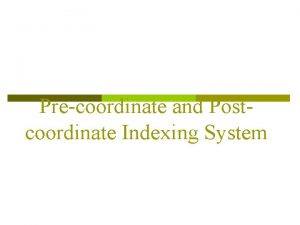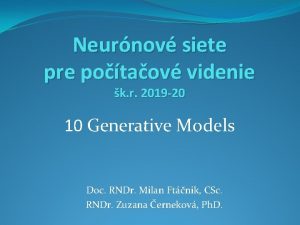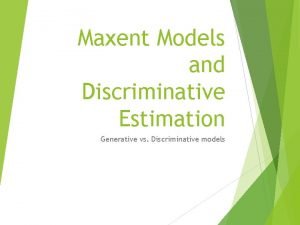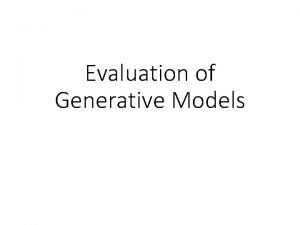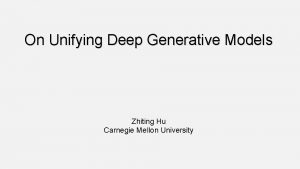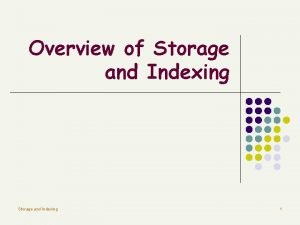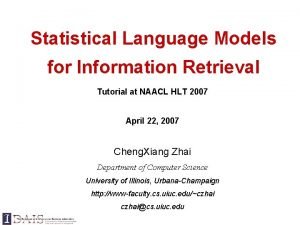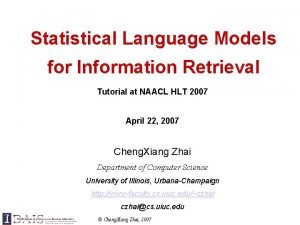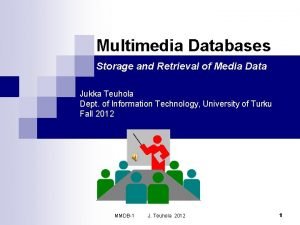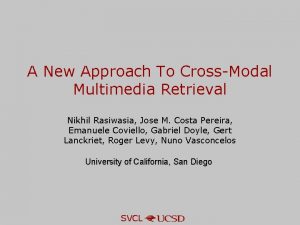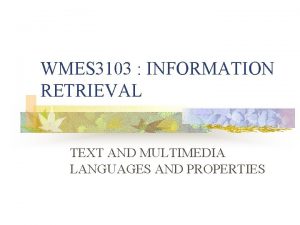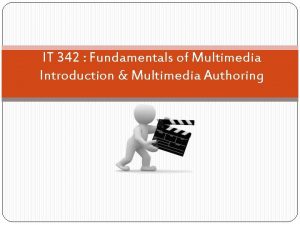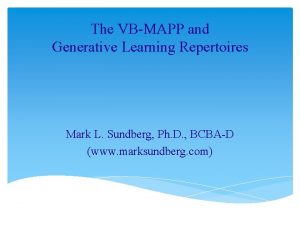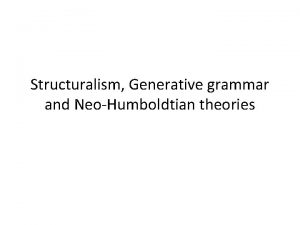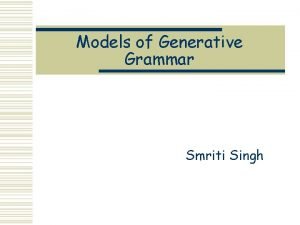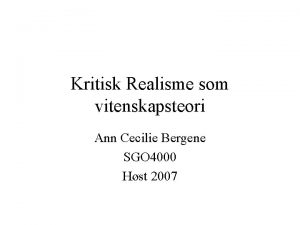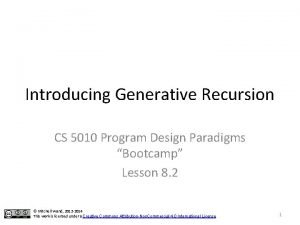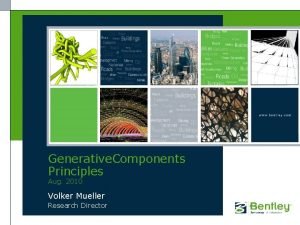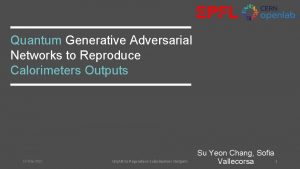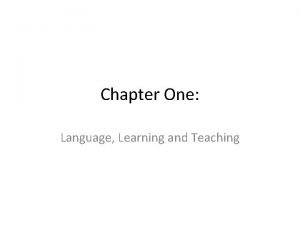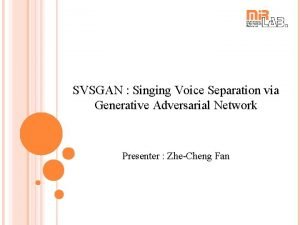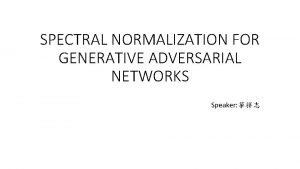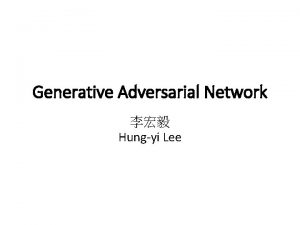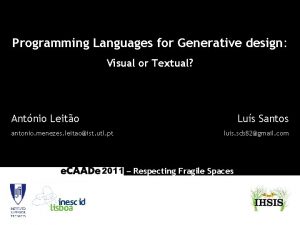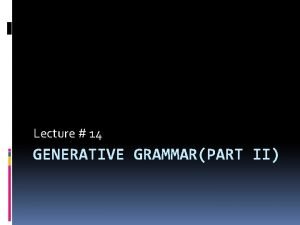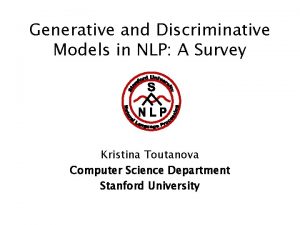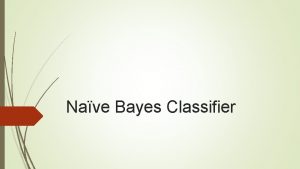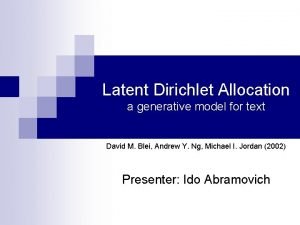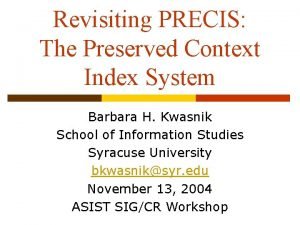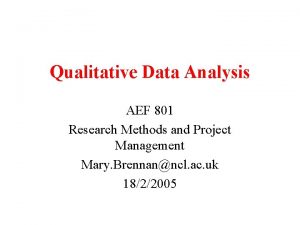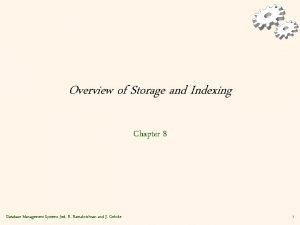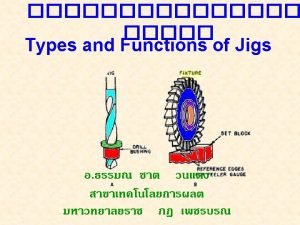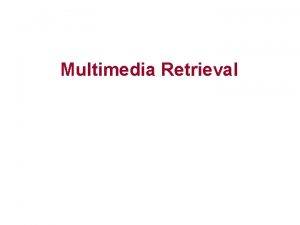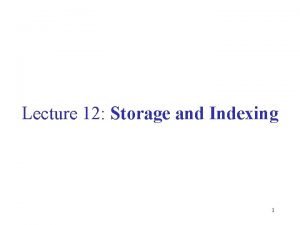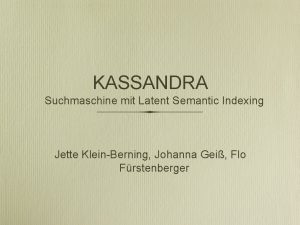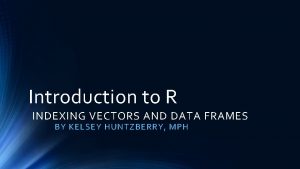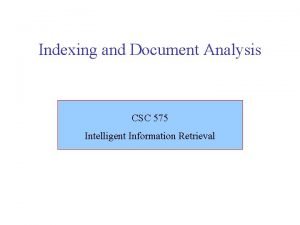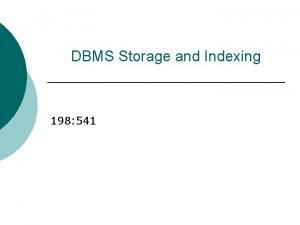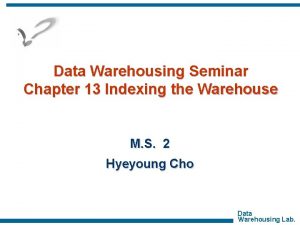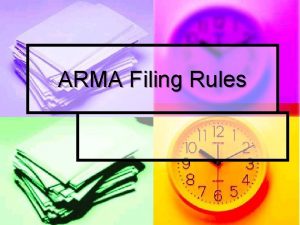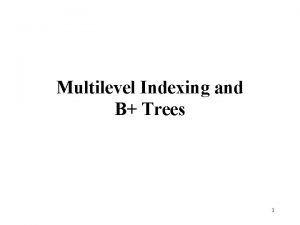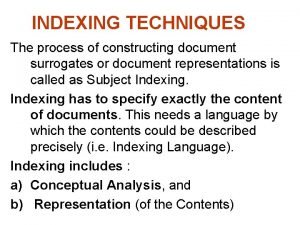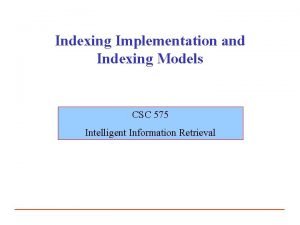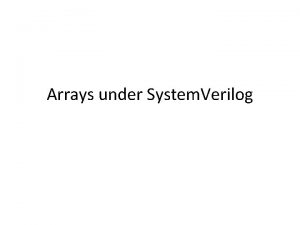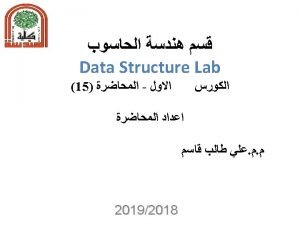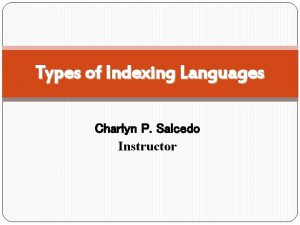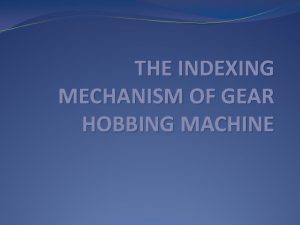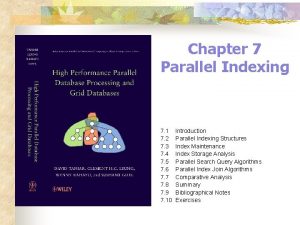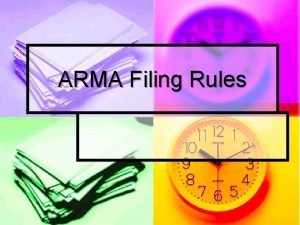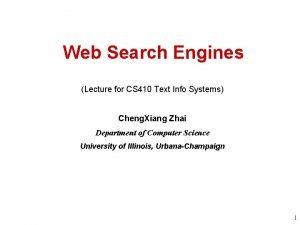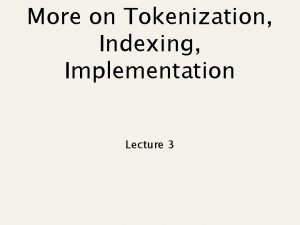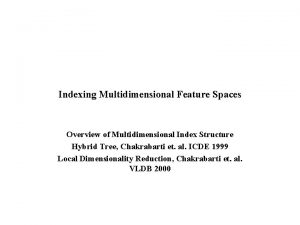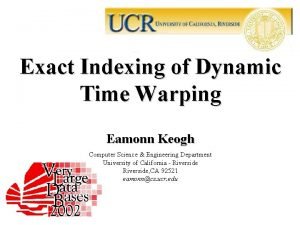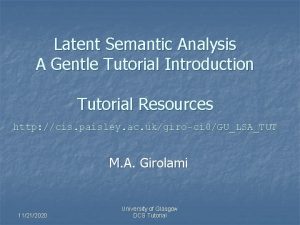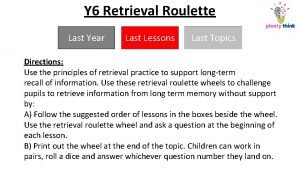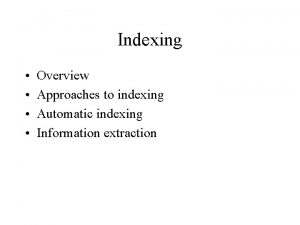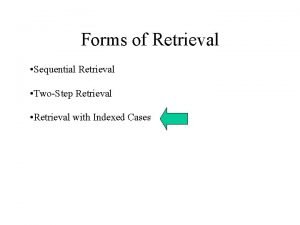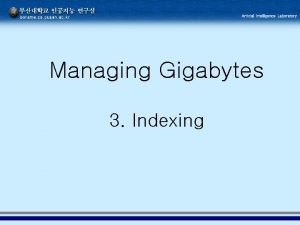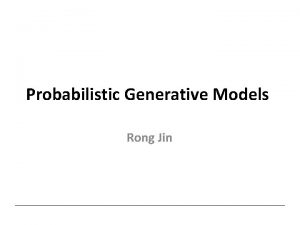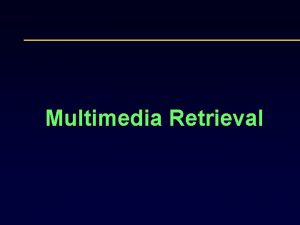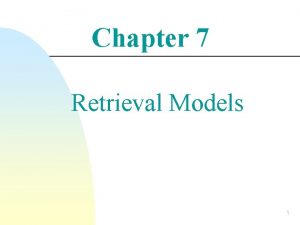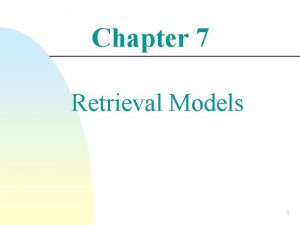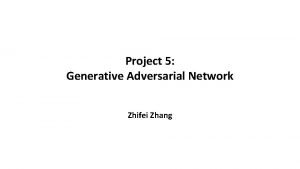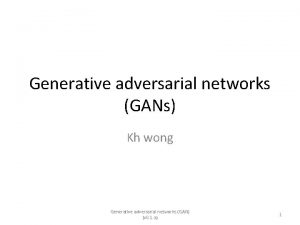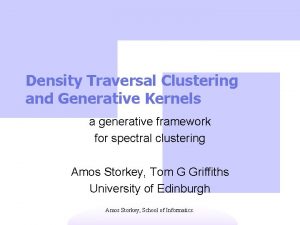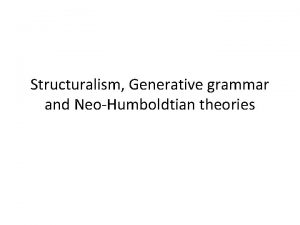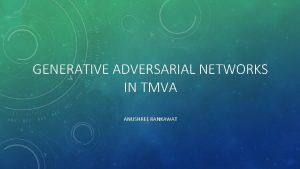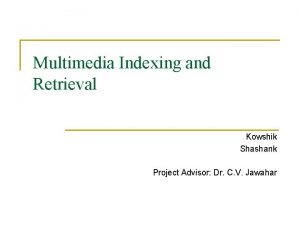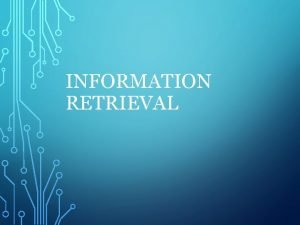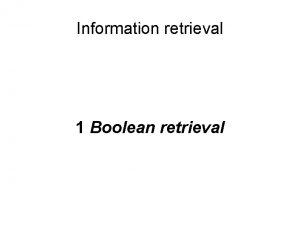Multimedia Retrieval Outline Overview Indexing Multimedia Generative Models



















































































- Slides: 83

Multimedia Retrieval

Outline • Overview Indexing Multimedia • Generative Models & MMIR – Probabilistic Retrieval – Language models, GMMs • Experiments – Corel experiments – TREC Video benchmark

Indexing Multimedia

A Wealth of Information Speech Audio Images Temporal composition Database

Associated Information gender name country Player Profile history Biography id picture

User Interaction Poses a query Gives examples Views Evaluates query text video segments results feedback Database

Indexing Multimedia • Manually added descriptions – ‘Metadata’ • Analysis of associated data – Speech, captions, OCR, … • Content-based retrieval – Approximate retrieval – Domain-specific techniques

Limitations of Metadata • Vocabulary problem – Dark vs. somber • Different people describe different aspects – Dark vs. evening

Limitations of Metadata • Encoding Specificity Problem – A single person describes different aspects in different situations • Many aspects of multimedia simply cannot be expressed unambiguously – Processes in left (analytic, verbal) vs. right brain (aesthetics, synthetic, nonverbal)

Approximate Retrieval • Based on similarity – Find all objects that are similar to this one – Distance function – Representations capture some (syntactic) meaning of the object • ‘Query by Example’ paradigm

Feature extraction N-dimensional space Ranking Display

Low-level Features

Low-level Features

Query image

So, … Retrieval? !

IR is about satisfying vague information needs provided by users, (imprecisely specified in ambiguous natural language) by satisfying them approximately against information provided by authors (specified in the same ambiguous natural language) Smeaton

No ‘Exact’ Science! • Evaluation is not done analytically, but experimentally – real users (specifying requests) – test collections (real document collections) – benchmarks (TREC: text retrieval conference) – Precision – Recall –. . .

Known Item

Query

Results …

Query

Results …

Semantic gap… concepts ? features raw multimedia data

Observation • Automatic approaches are successful under two conditions: – the query example is derived from the same source as the target objects – a domain-specific detector is at hand

1. Generic Detectors

Retrieval Process Database Query Parsing Query type Nouns Adjectives Detector / Feature selection Filtering Ranking Camera operations Invariant People, Names color spaces Natural/physical objects . .

Parameterized detectors Example Topic 41 Query text People detector <1, 2, 3, many> Results

Query Parsing Find The query type Nouns Adjectives Other examples of overhead zooming in views of canyons in the Western United States + names

Detectors The universe and everything F O C U S Camera operations (pan, zoom, tilt, …) People (face based) Names (Video. OCR) Natural objects (color space selection) Physical objects (color space selection) Monologues (specifically designed) Press conferences (specifically designed) Interviews (specifically designed) Domain specific detectors

2. Domain knowledge

Player Segmentation Original image Initial segmentation Final segmentation

Advanced Queries Show clips from tennis matches, starring Sampras, playing close to the net;

3. Get to know your users

Mirror Approach • Gather User’s Knowledge – Introduce semi-automatic processes for selection and combination of feature models • Local Information – Relevance feedback from a user • Global Information – Thesauri constructed from all users

Feature extraction N-dimensional space Clustering Ranking Concepts Display Thesauri

Low-level Features

Identify Groups

Representation • Groups of feature vectors are conceptually equivalent to words in text retrieval • So, techniques from text retrieval can now be applied to multimedia data as if these were text!

Query Formulation • Clusters are internal representations, not suited for user interaction • Use automatic query formulation based on global information (thesaurus) and local information (user feedback)

Interactive Query Process • Select relevant clusters from thesaurus • Search collection • Improve results by adapting query – Remove clusters occuring in irrelevant images – Add clusters occuring in relevant images

Assign Semantics

Visual Thesaurus Glcm_47 Correct cluster representing ‘Tree’, ‘Forest’ ‘Incoherent’ cluster Fractal_23 Mis-labeled cluster Gabor_20

Learning • Short-term: Adapt query to better reflect this user’s information need • Long-term: Adapt thesaurus and clustering to improve system for all users

Thesaurus Only After Feedback

4. Nobody is unique!

Collaborative Filtering • Also: social information filtering – Compare user judgments – Recommend differences between similar users • People’s tastes are not randomly distributed • You are what you buy (Amazon)

Collaborative Filtering • Benefits over content-based approach – Overcomes problems with finding suitable features to represent e. g. art, music – Serendipity – Implicit mechanism for qualitative aspects like style • Problems: large groups, broad domains

5. Ask for help

Query Articulation Feature extraction N-dimensional space How to articulate the query?

What is the query semantics ?

Details matter

Problem Statement • Feature vectors capture ‘global’ aspects of the whole image • Overall image characteristics dominate the feature-vectors • Hypothesis: users are interested in details

Irrelevant Background Query Result

Image Spots • Image-spots articulate desired image details – Foreground/background colors – Colors forming ‘shapes’ – Enclosure of shapes by background colors • Multi-spot queries define the spatial relations between a number of spots

Query Images Results Hist 16 Hist Spot+Hist 5968 6274 6098 5953 6612 6563 7062 7107 6888 7034 192 2 4 3 1 14 2 4 3 1

A: Simple Spot Query `Black sky’

B: Articulated Multi-Spot Query `Black sky’ above `Monochrome ground’

C: Histogram Search in `Black Sky’ images 2 -4: 14:

Complicating Factors • What are Good Feature Models? • What are Good Ranking Functions? • Queries are Subjective!

Probabilistic Approaches

Generative Models… • A statistical model for generating data – Probability distribution over samples in a given ‘language’aka M ‘Language Modelling’ P( |M) =P( |M) P ( | M, ) © Victor Lavrenko, Aug. 2002

… in Information Retrieval • Basic question: – What is the likelihood that this document is relevant to this query? • P(rel|I, Q) = P(I, Q|rel)P(rel) / P(I, Q) • P(I, Q|rel) = P(Q|I, rel)P(I|rel)

‘Language Modelling’ • Not just ‘English’ • But also, the language of – – author newspaper text document image • Hiemstra or Robertson? • ‘Parsimonious language models explicitly address the relation between levels of language models that are typically used for smoothing. ’

‘Language Modelling’ • Not just ‘English’ • But also, the language of – – author newspaper text document image • Guardian or Times?

‘Language Modelling’ • Not just English! • But also, the language of – – author newspaper text document image • or ?

Unigram and higher-order models P( ) =P( )P( | ) P( | • Unigram Models P( )P( ) • N-gram Models P( )P( | ) • Other Models – Grammar-based models, etc. – Mixture models © Victor Lavrenko, Aug. 2002 )

The fundamental problem • Usually we don’t know the model M – But have a sample representative of that model P( |M( )) • First estimate a model from a sample • Then compute the observation probability M © Victor Lavrenko, Aug. 2002

Indexing: determine models Docs Models • Indexing – Estimate Gaussian Mixture Models from images using EM – Based on feature vector with colour, texture and position information from pixel blocks – Fixed number of components

Retrieval: use query likelihood • Query: • Which of the models is most likely to generate these 24 samples?

Probabilistic Image Retrieval ?

Rank by P(Q|M) P(Q|M 1) P(Q|M 2) P(Q|M 3) P(Q|M 4) Query

Topic Models P(Q|M 1) Query P(D 1|QM) P(Q|M 2) P(Q|M 3) P(D 2|QM) P(D 3|QM) P(Q|M 4) Query Model P(D 4|QM) Documents

Probabilistic Retrieval Model • Text – Rank using probability of drawing query terms from document models • Images – Rank using probability of drawing query blocks from document models • Multi-modal – Rank using joint probability of drawing query samples from document models

Text Models • Unigram Language Models (LM) – Urn metaphor • P( © Victor Lavrenko, Aug. 2002 )~P( )P( ) = 4/9 * 2/9 * 4/9 * 3/9

Generative Models and IR • Rank models (documents) by probability of generating the query • Q: • P( | ) = 4/9 * 2/9 * 4/9 * 3/9 = 96/9 • P( | ) = 3/9 * 3/9 = 81/9 • P( | ) = 2/9 * 3/9 * 2/9 * 4/9 = 48/9 • P( | ) = 2/9 * 5/9 * 2/9 = 40/9

The Zero-frequency Problem • Suppose some event not in our example – Model will assign zero probability to that event – And to any set of events involving the unseen event • Happens frequently with language • It is incorrect to infer zero probabilities – Especially when dealing with incomplete samples ?

Smoothing • Idea: shift part of probability mass to unseen events • Interpolation with background (General English) – Reflects expected frequency of events – Plays role of IDF – +(1 - )

Hierarchical Language Model • MNM Smoothed over multiple levels Alpha * P(T|Shot) + Beta * P(T|‘Scene’) + Gamma * P(T|Video) + (1–Alpha–Beta–Gamma) * P(T|Collection) • Also common in XML retrieval – Element score smoothed with containing article

Image Models • Urn metaphor not useful – Drawing pixels useless • Pixels carry no semantics – Drawing pixel blocks not effective • chances of drawing exact query blocks from document slim • Use Gaussian Mixture Models (GMM) – Fixed number of Gaussian components/clusters/concepts

Key-frame representation split Y colour channels Cb Cr Take samples position DCT coefficients Query model 675 661 668 665 669 9 7 -7 10 -5 12 13 13 11 18 11 5 3 2 7 1 -5 -3 4 -3 9 11 0 5 1 4 3 -1 2 -5 1517 1536 1534 -9 2 0 0 0 -3 -4 -5 -5 -5 0 0 0 0 1 0 0 0 1 0 0 850 844 837 829 833 EM algorithm 15 5 3 0 -5 4 4 3 3 4 0 -2 -3 -1 -1 1 0 0 4 1 -2 0 3 -2 -2 1 0 -1 1 1 1 1 2 3 4 5

Image Models ? • Expectation-Maximisation (EM) algorithm – iteratively • estimate component assignments • re-estimate component parameters

Expectation Maximization E M Component 1 Component 2 Component 3

Expectation Maximization animation E M Component 1 Component 2 Component 3
 Chain indexing examples
Chain indexing examples Contoh pengindeksan manual
Contoh pengindeksan manual Do deep generative models know what they don’t know?
Do deep generative models know what they don’t know? Taxonomy of generative models
Taxonomy of generative models Generative vs discriminative models
Generative vs discriminative models Theis reference
Theis reference Zhiting hu
Zhiting hu Overview of storage and indexing
Overview of storage and indexing Statistical language models for information retrieval
Statistical language models for information retrieval Statistical language models for information retrieval
Statistical language models for information retrieval Storage and retrieval technologies in multimedia
Storage and retrieval technologies in multimedia A new approach to cross-modal multimedia retrieval
A new approach to cross-modal multimedia retrieval Multimedia information retrieval in irs
Multimedia information retrieval in irs It 342
It 342 What is the difference between models and semi modals
What is the difference between models and semi modals Quotation sandwich examples
Quotation sandwich examples Generative learning aba
Generative learning aba Generative grammar
Generative grammar Transformational grammar
Transformational grammar Eksempler på kritisk realisme
Eksempler på kritisk realisme Generative recursion
Generative recursion Deep and surface structure examples
Deep and surface structure examples Bentley generative components
Bentley generative components Generative safety culture in aviation
Generative safety culture in aviation Generative lymphoid organs
Generative lymphoid organs Generative thinking boards
Generative thinking boards Quantum generative adversarial learning
Quantum generative adversarial learning Structural linguistic and behavioral psychology
Structural linguistic and behavioral psychology Singing
Singing Spectral normalization
Spectral normalization Conditional generator
Conditional generator Generative meditation
Generative meditation Generative type computer aided process planning
Generative type computer aided process planning Generative design grasshopper
Generative design grasshopper Generative grammar examples
Generative grammar examples Nlp generative model
Nlp generative model Unsupervised image to image translation
Unsupervised image to image translation Bayes intranet
Bayes intranet Lda generative model
Lda generative model Generative thinking definition
Generative thinking definition Multimedia becomes interactive multimedia when
Multimedia becomes interactive multimedia when Linear and nonlinear in multimedia
Linear and nonlinear in multimedia Linear and nonlinear multimedia
Linear and nonlinear multimedia Esa multimedia.esa.int./multimedia/virtual-tour-iss
Esa multimedia.esa.int./multimedia/virtual-tour-iss 40:1 dividing head chart
40:1 dividing head chart Role of precis in indexing
Role of precis in indexing Cross referencing example
Cross referencing example Non-numerical unstructured data indexing
Non-numerical unstructured data indexing Tree based indexing in dbms
Tree based indexing in dbms Locating pins for jigs and fixtures
Locating pins for jigs and fixtures Image indexing
Image indexing Nmcn portal
Nmcn portal Tree based indexing in dbms
Tree based indexing in dbms What is keyword indexing
What is keyword indexing Latent semantic indexing
Latent semantic indexing R indexing
R indexing Csc // indexing
Csc // indexing Clustered b+ tree
Clustered b+ tree Indexing in data warehouse
Indexing in data warehouse Chain procedure in library science
Chain procedure in library science Arma indexing rules
Arma indexing rules What is this
What is this Multilevel indexing
Multilevel indexing In compound indexing index crank movement 40/n
In compound indexing index crank movement 40/n Blekko url
Blekko url What is an indices
What is an indices Document indexing methods
Document indexing methods Single pass in memory indexing
Single pass in memory indexing Verilog array indexing
Verilog array indexing An array element is accessed using
An array element is accessed using Types of indexing language
Types of indexing language Types of indexing mechanism
Types of indexing mechanism What is parallel indexing
What is parallel indexing Arma indexing rules
Arma indexing rules Uiuc cs 410
Uiuc cs 410 Recap indexing scans
Recap indexing scans Font search by image
Font search by image Post coordinate indexing example
Post coordinate indexing example Multidimensional indexing
Multidimensional indexing Exact indexing of dynamic time warping
Exact indexing of dynamic time warping Latent semantic indexing tutorial
Latent semantic indexing tutorial Retrieval roulette
Retrieval roulette Which statement is an example of a fixed action pattern?
Which statement is an example of a fixed action pattern? Sequential search
Sequential search
